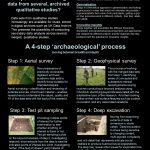The aim of the Working across qualitative longitudinal studies: a feasibility study looking at care and intimacy project was to explore the feasibility of conducting secondary data analysis across existing data from multiple qualitative and/or qualitative longitudinal studies. The project was funded by the ESRC as part of a package of research conducted by the National Centre for Research Methods. We developed procedures for working with multiple sets of in-depth temporal qualitative data to produce analyses that work with large volumes of data horizontally and vertically, exploring the feasibility of different approaches. Our strategy revolved around two key issues:
- the relationship between breadth of analysis and depth of analysis in working with large volumes of data across data sets; and
- the feasibility and value of taking a ‘test pit’ approach to trying out different, complementary forms of qualitative data analysis as a means of selecting cases for full analysis
We also wanted to contribute to emergent good practice in a new field, particularly the relationship between secondary analysts and the original team members who created the data set(s).
To address these questions we worked with existing data from empirical projects conducted under the ESRC funded Timescapes initiative. Our analysis focused on the substantive topic of care and intimacy to consider how we can answer questions about shifts in discourses and practices of care and intimacy over time and across the life course.
Background
Over the last 20 years there has been an increase in interest in the re-use of qualitative datasets for secondary analysis, and more recently long-term qualitative longitudinal research (QLR) investments. Within the UK, these moves have been supported by the development of infrastructure such as the UK Data Archive, and accompanied by the creation of procedures and practices for data sharing and re-use, as well as much debate around the epistemologies and ethics of doing so. The focus on re-use has been fuelled by a set of linked drives for:
- open data that is accessible to others
- the encouragement/requirement of funding bodies to share data
- a growth in researchers exchanging resources through a diverse range of mediums.
With the impetus to preserve qualitative data sets for the purposes of sharing and re-use comes the possibility of bringing together multiple archived data sets. This is, however, a new context for qualitative research and there is little guidance on how best to work with masses of qualitative material. We wanted to know whether it is possible to do ‘big qual’ analysis while retaining all that is distinct about rigorous qualitative research.

